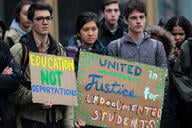You have /5 articles left.
Sign up for a free account or log in.
Over the last 40 years, I’ve observed the holiday season on seven public and private campuses (including undergraduate and graduate school). Each approached the end-of-year holidays differently. Many found expressions best suited for their community ethos: some focused on one religious point of view, others multiple, and some had no official acknowledgments of any kind.
I wasn’t much affected by the institutions solely focusing on Christmas. I had grown up Catholic, so while the expressions were lovely and familiar, I learned little except for the nuances I found in the institutions affiliated with Protestant sects. (Please note: At some point, I gave up trying to explain why Catholics go to midnight Mass at 11:00 p.m. on Christmas Eve and why it “counted” for going on Christmas Day.) Of the seven institutions, two stand out for affecting my worldview, instilling greater understanding and inspiring curiosity and a hunger for knowledge—all things most would argue are the aims of higher education.
The first was Boston University, my undergraduate alma mater. While initially affiliated with the Methodist Church, even in the early 1980s when I attended, it was already known for its diverse and international student body. One of the things BU did in the dining halls was to be highly conscious of cultural traditions surrounding food and religious holidays. The variety of culinary traditions were honored each day (including items permissible or not at certain times of the year for religious reasons). In addition, festive meals for holidays of all types gave us plenty to discover and discuss with our fellow students. Growing up Catholic in North Carolina in the 1970s never gave me this kind exposure to world beliefs and practices; I’m eternally grateful. (I did try to introduce collard greens, black-eyed peas, ham hocks and corn bread to my peers. Sadly, few seemed grateful to eat and learn about the good luck associated with consuming them on a holiday.)
Tangentially, but equally important to my knowledge of cultural traditions, was an undergraduate internship at the Slater Mill Historic Site in Pawtucket, R.I., in 1984. That year, the U.S. Supreme Court decided the landmark case Lynch v. Donnelly (also dubbed the “Reindeer Rule”). The case focused on the Christmas decorations purchased with city funds in Pawtucket and placed in Slater Mill Park (right next to the mill, where I was an intern). Daniel Donnelly (supported by the ACLU) objected to the display and brought claims against Pawtucket mayor Daniel Lynch.
The district court and the appeals court found in favor of the plaintiff. Next, the case was brought before the Supreme Court to consider whether the First Amendment’s Establishment Clause prohibited the display, which included a nativity scene, Santa and reindeer, a Christmas tree, a clown, animals, and other figures. (Frankly, I wonder why there was no objection to the clown in the display. WTF. Including a clown makes no sense whatsoever. You cannot change my mind on this.) A 5-to-4 decision determined that the secular and nonsecular items on display could not be prohibited because the display was not an endorsement of Christianity as a whole. The experience in Pawtucket taught me much about the Supreme Court, the First Amendment, the separation of church and state, and the public celebration of religious holidays.
While the Court settled Lynch v. Donnelly, cases continue to be argued in the courts about holiday displays today. The nature of holiday displays is also often discussed and debated on college campuses, especially at public institutions. This was true at one institution where I served as the art museum director. Longwood University, a public institution in Virginia, displayed a Christmas tree in the institution’s main historic building, known as the Rotunda. However, many campus constituents found offense in the focus on Christianity and called for the acknowledgment of other religious celebrations occurring at the same time of year.
In response, the administration decided to place displays depicting objects of religious significance from around the world in the space. As the museum director, I coordinated the efforts to select objects and provide interpretation. This was a daunting task and fraught with issues. For example, I wondered: Is it appropriate to place items related to private worship, such as a shrine, on public display? Was it ethical for a nonpractitioner to create a display that typically would be made as a part of a ritual performed by someone who practiced the faith? (I did contemplate what would happen to me for creating the Wiccan display since I wasn’t a practicing witch. Seriously, it felt disrespectful.)
Was it accurate or justifiable to equate Christmas (a major holiday for Christians) to a minor holiday for another religion by juxtaposing and placing the displays in the same context? What were we teaching by doing so? I also had difficulty finding experts on campus to help me, since we didn’t teach some of the subject areas involved.
It was challenging to research, to succinctly convey each holiday and to respectfully display the associated symbols. Nevertheless, the effort was beneficial even if imperfect, reactionary and problematic. By acknowledging various holidays and religious traditions, we learned something about each other, the world, biases and shortcomings, and how we can improve the learning environment for faculty, staff and students.
Our mission in higher education should always be about learning and understanding more—and that should include holidays, too.

